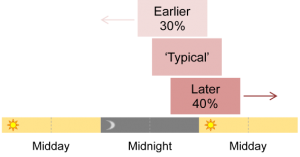In today’s world of sleep trackers and activity monitors, we are ever more conscious of our body’s rhythms and getting *enough* sleep. However, it’s not just how much we sleep that we need to pay attention to, but when we sleep – it has a much bigger impact on our body than you might expect!
Many of us already identify as a ‘lark’ or an ‘owl’, instinctively knowing whether we prefer to wake up bright and early or are more inclined towards enjoying the nightlife. Our biological clock shows a similar difference and drives different patterns of sleep timing across the population. This biological tendency for sleeping earlier or later is called a chronotype, but what’s the science behind this? And why does it matter?
Are you a lark or an owl?
Whilst there are now many online quizzes related to sleep cycles, the Munich ChronoType Questionnaire (MCTQ) is one of the most commonly used surveys in biological rhythms research to measure chronotype. The MCTQ was the first survey to consider the difference between sleep on working days and on free days (when we can follow our natural schedule). The questionnaire uses “free day sleep” to measure chronotype, because sleep timing on these days is more reflective of our internal clock and not the alarm clock.
The results of the MCTQ showed a range of chronotypes – after accounting for the difference between sleep duration on free days and workdays, the most common sleep pattern was between ~11:30pm/midnight and ~7:30/8am on free days. About 30% of people slept earlier, and 40% of people slept later. As a measure of sleep timing, rather than behaviour preferences, the MCTQ doesn’t use the larks and owls distinction. However, there is a clear link between early sleep timing and more ‘lark’-like preferences, and later sleep timing and ‘owl’-ish tendencies.

The most common sleep pattern (‘typical’) was between ~11:30pm/midnight and ~7:30/8am. 30% of people slept earlier than this, and 40% of people slept later than this.
But chronotype is not static. We tend to start as early types, and become progressively later as teenagers, which will be of no surprise to any parent. A turning point happens in our early 20s, and we start to become earlier again. Interestingly, gender also has an influence – women tend to be earlier types than men until around age 50, when this gender-difference disappears.
Social jet lag
On average, we wake up 2hrs earlier on work days than we do on free days. However, this is not accompanied by going to bed 2hrs earlier. This leads to a ‘sleep debt’ of around 1hr/day during the working week as we override our internal rhythm to meet society’s demands of a work or school schedule. The mismatch between our biological time and social time is termed social jet lag.
Despite most of the population having intermediate to late chronotypes, work and school hours are still in favour of larks, beginning early in the morning and leaving evenings free. As we try to conform to this schedule, the majority of us experience some degree of social jet lag. This is most extreme in the later chronotypes, who are forced to get up well before they would do on a free day. This has consequences beyond sleep: later chronotypes, with greater social jet lag, are associated with greater mental exhaustion and depressed mood, and are more likely to consume caffeine, cigarettes and alcohol.
Strategies to reduce social jet lag are already showing positive results. In a school setting, a simple delay of start time allows students to wake later and stay closer to their natural rhythm. In Seattle, a trial delaying the school start time by one hour increased sleep duration, decreased social jetlag, improved attendance and punctuality, and increased grades.
Variety is the spice of life
Although early birds are typically viewed as more productive, likely because their natural rhythm fits more closely with a 9-5 job, having a range of chronotypes in the workplace can be beneficial. In the laboratory, for example, the discovery of one protein was thrown into doubt when two opposing chronotypes performed the same experiment. When the ‘owl’ postdoc did the experiments in the evening, the protein was there, but when the ‘lark’ PhD student performed the same experiments in the morning, the protein was nowhere to be found. The answer? It was rhythmic! By chance, the difference in the lab’s working patterns led to a key discovery.
Taking it further, can we even use chronotypes to our advantage? In our ever-more 24/7 society, shift work is a feature of multiple industries – from manufacturing and transportation to the emergency services. In 2015, a study of factory workers used a ‘chronotype-adjusted’ schedule to match shifts with chronotypes. This meant no more early shifts for the late types, and no more late shifts for the early types. The new schedule successfully increased the amount of sleep the workers had on workdays, and they also reported better sleep quality and increased wellbeing.
Whilst it may not be practical to reschedule shift work entirely, workplaces could certainly trial similar measures to match working patterns to chronotypes. Even in an office environment, allowing for flexible schedules with ‘core hours’ in the middle of the day where both early and late types meet could improve productivity as everyone works to their own rhythm. After all: the early bird may catch the worm, but the second mouse gets the cheese!
